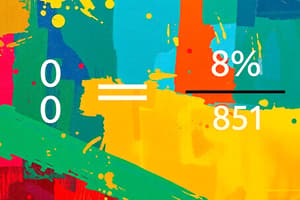Podcast
Questions and Answers
What is the equivalent fraction of 33.33%?
What is the equivalent fraction of 33.33%?
- 2/3 (correct)
- 1/4
- 1/3
- 3/4
If 25% of a certain number is 30, what is the number?
If 25% of a certain number is 30, what is the number?
- 90 (correct)
- 60
- 150
- 120
If an amount increases by 9.09%, what is the new total if the original amount was 220?
If an amount increases by 9.09%, what is the new total if the original amount was 220?
- 210
- 240 (correct)
- 250
- 230
What is 16.66% of 180?
What is 16.66% of 180?
What is the decimal equivalent of 5.55%?
What is the decimal equivalent of 5.55%?
If a student studied 14.28% of a course, what fraction of the course did they cover?
If a student studied 14.28% of a course, what fraction of the course did they cover?
Flashcards
Equivalent Fraction of 33.33%
Equivalent Fraction of 33.33%
The fraction that represents the same value as 33.33%.
Calculating Percentage of a Number
Calculating Percentage of a Number
Finding a specific percentage of a given number.
Finding the Original Number
Finding the Original Number
Determining the original number when a percentage of it is known.
Percentage Increase
Percentage Increase
Signup and view all the flashcards
Decimal Equivalent of a Percentage
Decimal Equivalent of a Percentage
Signup and view all the flashcards
Fraction of a Whole
Fraction of a Whole
Signup and view all the flashcards
Study Notes
Converting Fractions to Percentages
- All percentages can be represented as a ratio with the denominator as 100.
- Converting fractions to percentages and vice versa is useful for calculations.
- Common fractions and their percentage conversions should be learned, such as:
- 1/2 = 50%
- 1/3 = 33.33%
- 1/4 = 25%
- 1/7 = 14.28%
- 1/8 = 12.5%
- 1/9 = 11.11%
- 1/10 = 10%
Solving Percentage Problems
- To find a percentage of a number, multiply the number by the ratio equivalent to the percentage.
- For example, 14.28% of 560 = (1/7) × 560 = 80.
- To find a percentage when the ratio is not exact, convert the ratio to an equivalent fraction and then multiply. For example, 37.5% of 720 = (3/8) × 720 = 270.
Understanding Percentages
- A percentage is essentially a ratio.
- For example, 25% of a certain number of sweets means 25 out of 100 sweets, or 9 out of 36 sweets, or 1 out of 4 sweets.
- This ratio approach can be used to understand and calculate percentage problems.
Studying That Suits You
Use AI to generate personalized quizzes and flashcards to suit your learning preferences.




